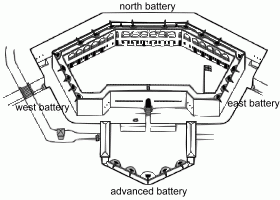 Many of the features of successful medieval castles were maintained in the New World during the 1700's and 1800's, when the French, British, and Americans constructed forts to defend their possessions. Because of the widespead use of gunpowder and cannons, the walls of these forts had to be very thick. Let's look at two of the most famous forts in Canada, Fort Henry in Kingston, Ontario, and Fortess Louisburg in Cape Breton, Nova Scotia. Fort Henry was built by England near the Lake Ontario entrance to the St. Lawrence River during the years 1832 to 1837, to protect the naval dockyard at Point Frederick, the entrance of the Rideau Canal, and the town of Kingston, which was a major shipping centre on the supply route between Montreal and the west. The British Army manned Fort Henry until 1870, when Queen Victoria's troops were pulled out of Canada. Forts in the New World were often designed and constructed in the same manner as a castle, except that they had to have considerably thicker walls to withstand the much more powerful cannon fire of the time.  On the left is a diagram of Fort Henry. You can clearly see the familiar castle layout, especially the double wall at the main entrance. There are some major differences, however.
On the left is a diagram of Fort Henry. You can clearly see the familiar castle layout, especially the double wall at the main entrance. There are some major differences, however.Much thicker walls protected against cannon fire. Towers are absent, probably because the fort was situated on a high cliff, protecting against invasion from the water below it. The interior buildings are all situated close against the walls, which were thick enough to protect them , and where they wouldn't be affected by falling artillery shells. Archery slits on the outer walls have been replaced by batteries of artillery pieces on the tops of the walls. These cannons were very effective when firing downwards at ships in the harbour below.
Fortress Louisburg Supposedly impregnable, the fort was never manned with enough soldiers to defend it properly, and it fell to English and American forces several times. Fortress Louisburg's archaeological collections, which include several million artifacts, as well as the fort itself, are an invaluable research tool available for study by visiting scholars. |